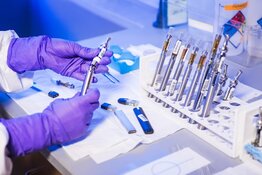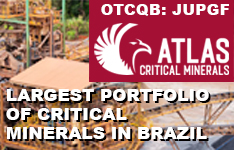The Life Sciences Report: You were involved early with Netscape. What did you do at the company?
Patrick Cox: I consulted directly with Jim Barksdale, who was CEO. I was also involved with technical reports and worked with the product manager on the original browser, which changed the world.
TLSR: You saw how the Internet became democratized because of Netscape. It was platform-agnostic, and it was truly disruptive. How does that inform your thinking, especially with regard to investing in healthcare technologies?
PC: The interesting thing about Netscape was how many supposedly smart analysts considered it, at best, to be a marginal change and, at worst, a fad. In fact it was completely disruptive. The world as we knew it changed entirely. That was a result of Moore's Law, and very few people saw it coming.
Moore's law describes the doubling of computing capacity, maybe every 18 months, at a consistent price level. This doubling accelerates technological change in ways most people are incapable of dealing with intellectually and emotionally. It was interesting to watch the phenomenon from the inside at Netscape. Today that same kind of technological acceleration is taking place in the biotechnology field. Just as people were incapable of understanding the magnitude of the law in terms of computing and networks, most people are incapable of understanding how extremely fast biotechnologies are now moving, and how that fact will impact their health, life spans and equities.
TLSR: To many investors, the newer technologies look like scientific experiments. People want to know when these ideas can be monetized. Aside from bone marrow transplants, when do you think we'll begin to see stem cell therapies routinely used in regenerative medicine?
PC: We will see that in the next few years. The first big-pharma collaboration and deal has already been cut. Teva Pharmaceutical Industries Ltd. (TEVA:NASDAQ) has an agreement with BioTime Inc. (BTX:NYSE.A) for stem cell technology used in the treatment of retinal disease. Teva is paying for the entire process, so I think it will move forward quickly. We already know that the technology works because of recent experiments performed by Advanced Cell Technology Inc. (ACTC:OTCBB). Development of these cell technologies were, not coincidentally, headed by Dr. Michael West, the man who now runs BioTime.
There is a difference between the two retinal stem cell technologies. The Advanced Cell Technology method involves loose cells. The BioTime/Teva technology is a matrix actually inserted onto the retina, and we know it works. What remains is a question of regulatory approval, not of development. I don't second-guess regulators, but I think the dynamics of healthcare are such that we desperately need these proven cures, and regenerative therapies will therefore be accelerated. They have to be.
TLSR: It takes a long time to go from lab bench to proof of concept to approval and finally to market. These steps can take 15–20 years.
PC: It can take that long, but many of these technologies have already been in the works for 15 or 20 years. These are not small-molecule drugs, following the old model of finding an interesting molecule, modifying it, getting a patent, testing it in animals, testing it for safety with patients and then hopefully getting it to market. That is definitely a 15–20 year process. But with regenerative medicine, we are duplicating processes that are going on right now in a patient's body, so we know they work. In fact, often these therapies involve using the patient's own cells—or even better, they involve modifying the patient's own cells.
TLSR: What is the most exciting thing going on now?
PC: The most exciting regenerative medicine technology is at BioTime subsidiary ReCyte Therapeutics Inc. Taking cells from a donor that are the equivalent of embryonic stem cells (ESCs), BioTime then reprograms the cells. BioTime and the Wistar Institute in Philadelphia have jointly discovered technology that applies to the natural limits of cell replication—how many times a cell can replicate before it just stops. They have identified the gene, known as SP100, that allows the heterochromatin part of the chromosome to open up and revert to the embryonic state, with complete renewal of the telomere, and have discovered the means for creating these induced pluripotent stem (IPS) cells quickly, safely and efficiently. The IPS cells can then be turned into any of the hundreds of cell types that BioTime has patented.
"The return on these disruptive, world-changing technologies is so great that if you own it for a couple of years longer than you thought you needed to, you're still going to beat the market by orders of magnitude."TLSR: You have written that the discovery of the role of the SP100 gene is, in your opinion, "monumental." You said it delivers "administrator access" to the genome, so that investigators can create IPS cells. Is that for purposes of cell number expansion or for differentiating those stem cells into specific cell types?
PC: It is for both those things, and more importantly it is for complete rejuvenation. Let me explain rejuvenation versus regeneration. A good example of regenerative medicine is in treatment following a heart attack. When a patient has a heart attack, heart muscle is lost and there was nothing that could be done about it. The patient simply suffered until he died. By injecting autologous (the patient's own) heart stem cells, the heart muscle will grow back. But taking a little bit of the patient's heart muscle and expanding stem cells from that tissue creates cells that are as old as the patient is, which is typically too old. The heart is repaired, but it is repaired with the same aged cells that led to failure.
TLSR: In other words, the traditional non-IPS autologous cells are programmed for the same exact disease phenotype that the patient suffers from.
PC: Right. But what IPS cells do, and what BioTime can do, is reboot the cells, to use some IT jargon. When the heart is repaired, it is with heart tissue the patient had when he was a child, and it has a life span of well over 100 years. That is rejuvenation. Using its cell matrix technology BioTime has shown that when these cells are attached to the inside of a patient's heart, there is an order of magnitude improvement as opposed to what might be seen with just a simple injection of propagated stem cells.
TLSR: When can BioTime monetize this technology?
PC: Its matrix technology is a device, and it is already being used in hundreds of research labs. I think that in about two years we are going to see the matrix technology adopted, especially in Europe, through its CE mark process (conformité Européene, meaning European conformity mark).
TLSR: When should an investor buy BioTime?
PC: People asked: When do we buy Apple? When do we buy Microsoft? When do we buy IBM? What I said then and what I say now is, look at the huge transformational technologies and stop worrying about timing. We're not traders. The return on these disruptive, world-changing technologies is so great that if you own it for a couple of years longer than you thought you needed to, you're still going to beat the market by orders of magnitude.
TLSR: You follow Provectus Pharmaceuticals Inc. (PVCT:OTCBB). Can you speak to that, please?
PC: Provectus is a fantastic story. The original Paul Ehrlich (1854–1915) was a German scientist who came up with the term "magic bullet," which has become critically important in the history of disease therapies. He found dyes that had no effect on healthy cells but could change the color of an unhealthy cell. He surmised that if we can affect only an unhealthy cell, we can come up with magic bullets to cure disease but don't affect healthy cells.
The irony is that one of the dyes he was working with was rose bengal, which is a derivative of coal tar. It was used to dye wool a beautiful rose tint. Fast-forward 100 years to the Oak Ridge National Laboratory, where scientists look at rose bengal and realize it has interesting ions that can be modified and activated using light and radiation. They're really nanotech machines and vastly complex.
TLSR: The company is preparing for a phase 3 trial now of its 10% rose bengal solution in the treatment of melanoma patients. It needs a partner for this, doesn't it?
PC: Yes. I'm not worried about that. The data are just spectacular. A lot of people are looking at the company at this point.
TLSR: Would you recommend buying Provectus now?
PC: Don't even look at the price for five years. Come back then and buy me a beer.
TLSR: Another company you'd like to talk about?
PC: Staying on the topic of cancer, I would like to talk about Galectin Therapeutics (NAS:GALT). Cancers protect themselves by expressing galectin-3. These are lectins that, using Star Trek jargon, use a sort of cloaking shield to hide them from the immune system. When T cells approach a tumor, cancer galectin-3 attaches to the T cell and induces apoptosis (programmed cell death). The T cells don't get back to the thymus, and the thymus doesn't adapt and create more of the right cells to attack this cancer.
Normally, if you put cancer cells together with T cells, the cancer cells' galectin-3 shuts down the T cells, and they start to die. What the Ludwig Institute for Cancer Research showed was that if you take cultures of mixed cells and introduce galectin-3 blockers, the T cells rejuvenate and kill the cancer cells. It happens in animals and in test tubes full of the cancer.
The company has just begun dosing in a phase 1/2a trial with one of its galectin-inhibitor compounds, GM-CT-01, in combination with a peptide vaccine from the Ludwig Institute, the world's biggest nonprofit cancer research group, which is paying for this study. This is for advanced metastatic melanoma. When these tests are done, we will have efficacy data.
TLSR: Again, when does the investor make a purchase?
PC: By the time the phase 1 study is over, if the data are as positive as I expect they will be, a big-pharma partner will enter the picture, which means I want to be in now.
TLSR: You believe that a phase 1 trial could be that definitive and revelatory?
PC: I think it can be. Certainly phase 2a will be. The trials are going to proceed relatively quickly.
TLSR: Would you like to mention another company?
PC: Yes, one with another huge technology and brand-new science that has never been done before. My old friend Isaac Asimov (1920–1992) wrote about nanobots (nanorobotics), and now NanoViricides Inc. (NNVC.OB:OTCBB) actually has them. The science is about polymers to which ligands are attached, which act as signaling systems within the body. They are used to fight viruses. The company overloads these polymer structures, called nanomicelles, with ligands and puts them into the bloodstream. When a virus is present, it is more attracted to the little structures than to cells. The virus attempts to enter the nanomicelles, thinking they are regular cells, and in the process, it is enveloped. The virus releases its DNA or RNA, depending on the virus type, attempting to take over the cells' DNA—but, of course, the nanomicelle is not a cell. That's the end of the virus. At that point, it has spent itself and died.
In animal studies against flu, this treatment was three orders of magnitude more effective than Tamiflu (oseltamivir). It does not matter what type of flu is targeted, even the most dangerous—H1N1, H5N1. Within hours of receiving the treatment, a patient will have no symptoms; in 21 days the patient has immunity and will never have to worry about that flu again. The therapy could work against all the viral diseases that we worry about, from herpes and AIDS to Ebola, dengue fever and influenza.
Right now, NanoViricides is building its current good manufacturing practice (cGMP) facility in Connecticut. The question is, at what point does NanoViricides begin selling rights to these various nanovesicles to big pharma? I don't think it will be more than a year and a half from now.
TLSR: The drug candidate you're talking about is FluCide (NV-INF-1). The company just had its pre-investigational new drug (IND) application meeting with the U.S. Food and Drug Administration (FDA) at the end of March. When do you think this product will get into the clinic?
PC: In a year or a year and a half.
TLSR: I'm going to ask you the same question: When should an investor buy?
PC: You could buy it now or wait. Seriously, investors are too obsessed with timing. And timers don't always win in the long run.
TLSR: You've talked about timers twice now. Let me segue to a company that sounds like one of your favorites because you wrote long about it in May: OncoSec Medical Inc. (ONCS:OTCBB).
PC: It's an important company. It doesn't want to be thought of as a device company, but it has a patent on the use of electroporation for the delivery of drugs. Using very small electrical charges, cell walls are opened up so that you can deliver drugs. OncoSec is focused on a specific cancer drug right now, which could have as much potential as Provectus' rose bengal. I think it's going to do well.
TLSR: OncoSec is down 91% from 52 weeks ago, and it's a $9 million (M) market cap company. Could day traders destroy this company?
PC: I don't know. That's a really good question. I don't think so.
TLSR: Are you worried about the significant market cap decline?
PC: That doesn't really concern me because I never valued it at that market cap. Not then or now. I didn't recommend it a year ago when it was that high. What the company needs to do is demonstrate efficacy, and I think it will do that. Then you're going to see not only interest in the drug it is testing but also the application of its device to a bunch of other drugs.
TLSR: You also follow Star Scientific Inc. (NAS:CIGX). Could you speak to that?
PC: I certainly could. If you're a timer, that's the one company that you should be watching most closely. Its sales are skyrocketing, but there are several things that could change its status dramatically and very quickly. R. J. Reynolds Tobacco Co. and Star have been locked in a patent lawsuit for years now, but about six months ago Star got word from the U.S. Patent Office that its prior claim to the method of tobacco curing that reduces tobacco-specific nitrosamine carcinogens by about 80% belongs to Star. Just recently, the judge ordered R. J. Reynolds to begin settlement discussions with Star. That is potentially a multibillion-dollar award.
But that is not the primary reason for holding the stock. The technology that came out of Star Scientific's efforts to ameliorate the damage of smoking led it to discover the alkaloid in tobacco that is responsible for the monoamine oxidase inhibition associated with tobacco use. You know what monoamine oxidase inhibitors (MAOIs) are?
TLSR: Antidepressants.
PC: Tobacco is one of the best MAOIs, maybe the best MAOI that has ever existed. Using tobacco is reversible, and it is dose-dependent. But its effect is not due to the presence of nicotine; nicotine is not an MAOI. The problem is that smoking does massive damage to your lungs and cardiovascular system.
It wasn't until Star Scientific did the research looking for a smoking cessation technology that it identified anatabine, the other alkaloid in tobacco. It released anatabine as a smoking cessation lozenge, and almost immediately discussion groups on Yahoo popped up with people talking about significant amelioration of inflammation-related diseases. That led the company to further investigate anatabine. To make a long story short, it has now entered into research arrangements with the Roskamp Institute, the most important cognitive research institute in the world as far as I can tell. What has been discovered is that anatabine citrate, sold under the trade name Anatabloc as a nutraceutical, has pretty astonishing effects on inflammation-related diseases.
TLSR: You wrote that you use Anatabloc.
PC: Yes, I've written about it. I have nightmares where the FDA has banned it, and I've run out. It has changed my life. My C-reactive proteins (CRPs) have just plummeted. It down-regulates the NF-kappa B transcription factor that sets off the alarm for disease that is responsible for autoimmune disorders. The bottom line is that age-related autoimmune disorders, which we all have, are significantly reduced. It will have a very measurable impact on demographics, on healthcare costs, and on practically everything.
TLSR: Are you saying that Anatabloc is an NF-kappa B inhibitor?
PC: Not an inhibitor but a moderator, because it doesn't stop normal healing processes. That would be bad. This is not an immune suppressor. It is an immune tuner. Somehow, it is resulting in the up-regulation of T-reg (regulatory T) cells.
TLSR: Star Scientific is a small cap with a more than $500M market cap, but it is up about 18% over the past four weeks. I know you don't pay attention to short-term performance, but next to all of these other companies, it is the one with recent upward movement.
PC: The company has been presenting more and more data. It just started a clinical test on treating Alzheimer's disease with Anatabloc, and is enrolling patients. Johns Hopkins is doing thyroid studies. Somebody will take on studies on multiple sclerosis. The product is already widely used by tens of thousands of people. It has been one of the bestsellers on the GNC website for some time now because word is getting out. Patients with irritable bowel syndrome are reporting complete recovery. People with rosacea are reporting that it is going away. This is entirely unexpected. I understand how unlikely it seems, and if I were a different kind of an analyst, I wouldn't talk about it. But the fact of the matter is that this is a world-changing technology.
TLSR: Patrick, thank you for your time.
PC: Thank you.
Patrick Cox has lived deep inside transformative technologies for more than 25 years. In the 1980s, he worked in software development and manufacturing. By the mid-'90s he consulted for Netscape, which was handling 90% of Internet browsing traffic at the time. InfoWorld and USA Today have featured his research, and he has written for The Wall Street Journal, Los Angeles Times, USA Today and Reason Magazine. Cox has appeared on "Crossfire" and "Nightline," and been written up in The Baltimore Sun and CNBC Magazine. Currently Cox contributes to The Daily Reckoning and edits Breakthrough Technology Alert and Technology Profits Confidential, uncovering transformational technologies that offer exponential gains.
Want to read more exclusive Life Sciences Report interviews like this? Sign up for our free e-newsletter, and you'll learn when new articles have been published. To see a list of recent interviews with industry analysts and commentators, visit our Exclusive Interviews page.
DISCLOSURE:
1) George S. Mack of The Life Sciences Report conducted this interview. He personally and/or his family own shares of the following companies mentioned in this interview: None.
2) The following companies mentioned in the interview are sponsors of The Life Sciences Report: OncoSec Medical Inc. and Provectus Pharmaceuticals Inc. Streetwise Reports does not accept stock in exchange for services. Interviews are edited for clarity.
3) Patrick Cox: I personally and/or my family own shares of the following companies mentioned in this interview: None. I personally and/or my family am paid by the following companies mentioned in this interview: None. I was not paid by Streetwise Reports for participating in this story.














































